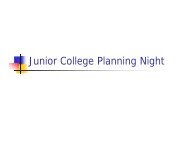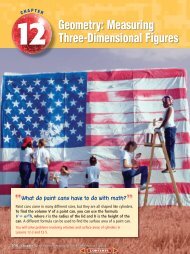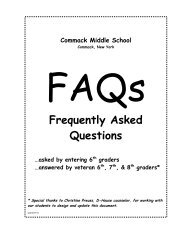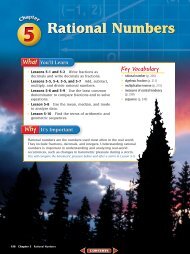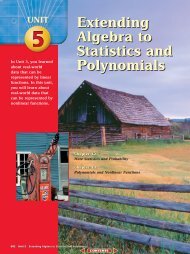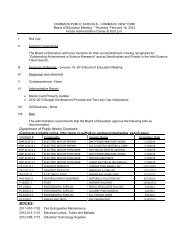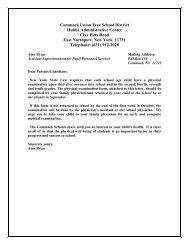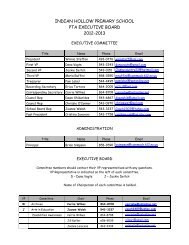Preparing for the Regents Examination Geometry, AK
Preparing for the Regents Examination Geometry, AK
Preparing for the Regents Examination Geometry, AK
Create successful ePaper yourself
Turn your PDF publications into a flip-book with our unique Google optimized e-Paper software.
28 Enclose PAT in a large rectangle and subtract<br />
<strong>the</strong> excess areas.<br />
a Area of PAT 120 60 24 6 12<br />
18<br />
b AT 10<br />
c 3.6<br />
29 a SA SM √ 52 ; sides are congruent.<br />
Slope of −−<br />
SA 3 _ , slope of<br />
2 −−−<br />
SM 2 _ ;<br />
3<br />
slopes are negative reciprocals, <strong>the</strong>re<strong>for</strong>e<br />
perpendicular and <strong>for</strong>ming a right angle.<br />
b A 1 _ (SA)(SM) 26<br />
2<br />
c √ 26<br />
30 Subdivide pentagon SIMON into two triangles<br />
and a trapezoid and take <strong>the</strong> sum of all<br />
<strong>the</strong> areas.<br />
Area 72<br />
31 Divide pentagon JANET into two triangles<br />
and take <strong>the</strong> sum of <strong>the</strong> two areas.<br />
Area 64<br />
32 Enclose quadrilateral RYAN in a large rectangle<br />
and subtract <strong>the</strong> excess areas.<br />
Area 72 13 _ 6 12 12 35.5<br />
2<br />
33 −−<br />
NI and −−<br />
CK have zero slope, <strong>the</strong> two sides are<br />
parallel. −−−<br />
NK −−<br />
IC m √ 10 . There<strong>for</strong>e, NICK<br />
is an isosceles trapezoid.<br />
34 Slope of −−<br />
JO slope of −−−<br />
HN 1 _ ; <strong>the</strong> sides are<br />
3<br />
parallel. Slope of −−<br />
NJ 3. The slopes are<br />
negative reciprocals, <strong>the</strong>re<strong>for</strong>e perpendicular,<br />
<strong>for</strong>ming a right angle. Slope of −−−<br />
OH is not<br />
equal to <strong>the</strong> slope of −−<br />
NJ , <strong>the</strong>re<strong>for</strong>e, only one<br />
pair of sides are parallel. JOHN is a right<br />
trapezoid.<br />
35 a 38 b 28 c 28 d (5, 4)<br />
Chapter Review (pages 245–248)<br />
1 (4) The diagonals of a parallelogram bisect<br />
each o<strong>the</strong>r.<br />
2 (4) mB mC 360<br />
3 (1) rhombus<br />
4 (1) a rhombus<br />
5 (3) A rhombus is a square.<br />
6 (4) parallelogram<br />
7 (3) 3<br />
8 (4) −−<br />
QS and −−<br />
PR bisect each o<strong>the</strong>r.<br />
9 (1) <strong>the</strong> diagonals are congruent<br />
10 a square b rhombus<br />
c parallelogram d rectangle<br />
66 Chapter 10: Quadrilaterals<br />
11 3x 4 0 x 50<br />
x 5<br />
12 5<br />
13 5 x 90<br />
x 18<br />
14 (3x 20) (7x 4 0) 180<br />
x 20<br />
15 2<br />
16 mDAE 90 75 15<br />
17 (4, 3)<br />
18 3x 1 5 7x 55<br />
x 10<br />
19 a mACD mCAB 30<br />
b rectangle<br />
180 75<br />
20 mAEK _ 52.5<br />
2<br />
21 5 ft<br />
22 (1, 1)<br />
23 3 √ 2<br />
24 mA 45<br />
25 h 8<br />
26 Rhombus. Since <strong>the</strong> triangles are congruent,<br />
<strong>the</strong> opposite angles that are originally vertex<br />
angles are congruent. By <strong>the</strong> addition postulate,<br />
<strong>the</strong> opposite angles <strong>for</strong>med by joining<br />
<strong>the</strong> triangles at <strong>the</strong>ir bases are congruent.<br />
Thus <strong>the</strong> quadrilateral is a parallelogram.<br />
All sides are congruent. The parallelogram is<br />
a rhombus.<br />
27 PS QR<br />
2x 3 x 2<br />
x 5<br />
PS QR SR PQ 7<br />
28 a (2x 8) 3(x 3 4) 180<br />
x 14<br />
mABC mCDA 144<br />
mDAB mBCD 36<br />
b AE EC<br />
4 y 6y 36<br />
y 18<br />
BE ED<br />
3x 1 x 13<br />
x 7<br />
AC 144, BD 40<br />
29 mABP mBAP 90<br />
(5x 10) (2x 4) 90<br />
x 12<br />
mDCB 140, mAPB 90<br />
30 a mR 150 b mRAD 150<br />
c mGAD 135 d mD 30




